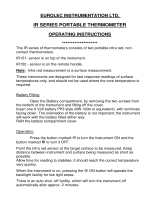
17
6.1 PARTS LIST FOR MODELS 865 AND 866
SCHEMATIC SCHEMATIC
DESIG. DESCRIPTION LOCATION
BA101 9V Alkaline Battery, NEDA 1604 F1
C101 Capacitor, 0.047, 50V Metalized Polypropylene E2
C102 Capacitor, 0.1
µ
F, 50V Ceramic F1
C103 Capacitor, 0.1
µ
F, 50V Ceramic G1
C104 Capacitor, 0.33
µ
F, 63V Metalized Polyester E2
C105 Capacitor, 0.33
µ
F, 63V Metalized Polyester D3
C106 Capacitor, 0.33
µ
F, 63V Metalized Polyester D1
C107 Capacitor, 1000p, 1000V Ceramic Disc. C2
C108 Capacitor, 0.1
µ
F, 50V Ceramic F1
C109 Capacitor, 0.33
µ
F, 63V Metalized Polyester E3
C110 Capacitor, 0.33
µ
F, 63V Metalized Polyester E3
C111 Capacitor, 0.33
µ
F, 63V Metalized Polyester E1
C112 Capacitor, 47pF, 500V Silver Mica or Ceramic E2
DS101 3
1
⁄2" Digit Liquid Crystal Display G4
J1001
1
⁄4" Phone Jack A1
J1002 Battery Clip E1
J1003 Battery Clip F1
Q101 NPN Transistor, MPS8099 C2
R101 Resistor, 910 kilohms, 5%,
1
⁄4W, Composition E2
R102* Resistor, 5.4 kilohms, 0.1%,
1
⁄8W, Metal Film D4
R102** Jumper
R103 Factory selected, part of 865-600 B-6
R104* Resistor, 4.6 kilohms, 0.1%,
1
⁄8W, Metal Film D3
R104** Resistor, 10 kilohms, 0.1%,
1
⁄8W, Metal Film D3
R105* Resistor, 44 kilohms, 0.1%,
1
⁄8W, Metal Film D3
R105** Resistor, 21.77 kilohms, 0.1%,
1
⁄8W, Metal Film D3
R106* Resistor, 16.5 kilohms, 1%,
1
⁄8W, Metal Film C3
R106** Resistor, 6.34 kilohms, 1%,
1
⁄8W, Metal Film C3
R107 Thick Film Resistor Network SEV
R108 Factory selected, Part of 31410 E4
R109* Resistor, 3.92 kilohms, 1%,
1
⁄8W, Metal Film F5
R109** Resistor, 3.65 kilohms, 1%,
1
⁄8W, Metal Film F5
R110 Pot, 200 ohms E4
R111* Pot, 5 kilohms C3
R111** Pot, 2 kilohms C3
R112 Pot, 10 ohms D1
R113 Resistor, 392 kilohms, 1%,
1
⁄8W, Metal Film E2
S101 493T, Slide Switch SEV























